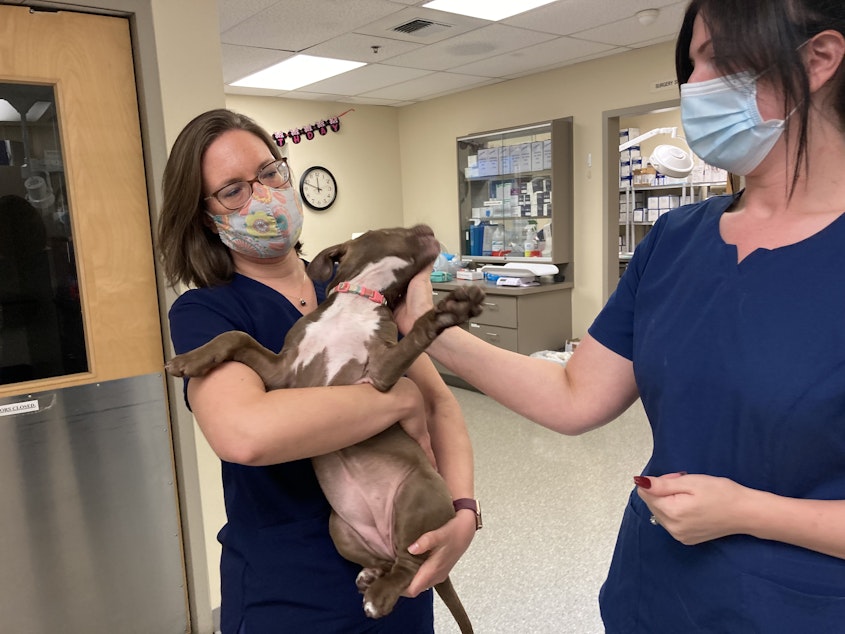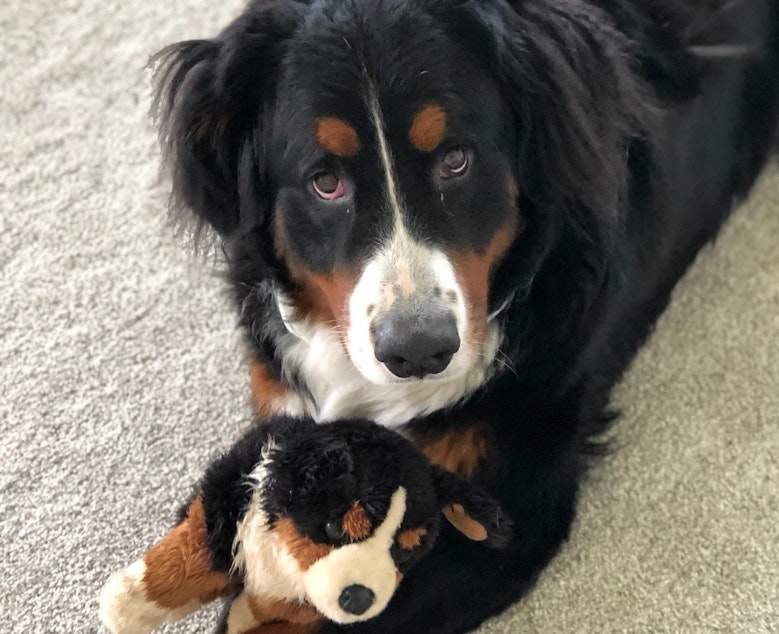Desperate times for pet owners and vets as clinics, hospitals are overwhelmed

It’s a problem nationally and in the Northwest. Pet owners are having trouble getting access to veterinary services. It’s another example of the fallout from the ongoing pandemic.
On a recent Sunday evening, Emily Wion’s three-year-old Bernese mountain dog, Ranger, was in distress. He was lethargic and his belly was distended and hard. Wion immediately suspected a stomach “flip,” a serious and potentially fatal condition that requires immediate surgery.
Wion, who lives on Mercer Island, called the nearest 24/7 veterinary emergency hospital and was told they were at capacity and to try elsewhere. It was the same answer everywhere else she called. Finally, a clinic in Renton agreed to see the dog.
Wion, her husband and teenage daughter jumped in the car with Ranger and headed south. At the clinic, Ranger was X-rayed and the veterinarian on duty confirmed he was indeed experiencing Gastric Dilation Volvulus (GDV), a condition where the stomach twists and cuts off blood flow.
It was an urgent situation, but there was no surgeon on duty. So, the staff in Renton sent the family to Seattle to meet a surgeon at its clinic there. But there was a miscommunication. By the time they arrived, the surgeon had taken another emergency case.
With Ranger on the verge of dying, there was only one other option: return to the clinic in Renton and have the vet there attempt the surgery. She was willing, but Wion said she warned the family that she had never done the surgery alone before. There were no guarantees.
“We just said ‘just take him’ and we said ‘you can do it, you can do it.’ And my daughter's, you know, hysterical,” said Wion, who posted about her experience on Facebook.*
A few hours later, they got a call that Ranger had survived the surgery and was in recovery. It was a happy ending to a harrowing several hours.
“It never would have crossed my mind that in a truly, truly life or death emergent situation we couldn't find someone [to care for our dog],” Wion said.

Ranger’s brush with death and his family’s struggle to find emergency veterinary care highlight an ongoing crisis in Washington, and across the nation. The COVID-19 pandemic has been described as a “perfect storm” for veterinary medicine.
Early on in the pandemic, spays and neuters and other procedures were postponed because of personal protective equipment (PPE) shortages. That created a backlog of demand for veterinary services when restrictions started to lift. Additionally, experts say, people forced to work from home were more likely to notice if their pet wasn’t feeling well.
It’s been widely reported that there was a pandemic-induced pet adoption boom that also contributed to the demand for veterinary services. However, data from shelters does not bear that out. In fact, Steve Zeidman of PetHealth, who tracks U.S. pet adoption trends, found that adoptions actually dropped by 24 percent.
The pandemic, though, did have other impacts.
A recent analysis published by the American Veterinary Medical Association (AVMA) noted that COVID-19 safety protocols required new workflows that may have slowed productivity.
“Transitioning to curbside care, splitting staff members into rotating teams, and sanitizing examination rooms and other surfaces throughout the clinic between visits are just a few of the changes that impacted how practices delivered veterinary services,” the report said.
Clinics also had to adjust when staff members were exposed to COVID-19 and had to quarantine. That contributed to an already high staff turnover rate in the industry.
“It’s well known that high turnover also hurts productivity and efficiency,” the AVMA report said. “Employee turnover and attrition remain high in veterinary medicine, especially when compared with other health care professions.”
Anecdotally, it appears turnover got worse during COVID as women, in particular, left the workforce in high numbers to care for children who were at home because schools were closed.
As the pandemic wore on, higher demand for veterinary services along with the ongoing staffing challenges combined to produce long waits to get an appointment. Many clinics also stopped accepting new patients. In response, some upset and stressed out pet owners took out their frustration on frontline staff. Now, veterinarians say, compassion fatigue is setting in leading to more resignations in an industry that even before COVID had workforce challenges.
At Chambers Creek Veterinary Hospital in Lakewood, a general practice clinic, the phone rings almost constantly. The clinic isn’t accepting new patients and existing patients often have to wait three to four weeks to get an appointment.
The few same-day appointments the clinic offers book-up almost immediately.
“It’s very stressful and tiring,” said Dr. Kelly Sandmeier, the managing veterinarian. “You want to be able to help as many pets as you can, which is why we got into this industry, and not being able to do that is hard.”
The crisis has also spilled over into emergency veterinary care with animal hospitals routinely turning away patients because they too are overwhelmed. For pet owners lucky enough to get in, they often endure an hours-long wait with their sick pet in the clinic parking lot.
“It’s heartbreaking. I’m here because I love animals,” said Dr. Lisa Parshley, co-founder of Olympia Veterinary Services, a 24/7 emergency and critical care facility that now routinely turns away patients because it’s at capacity.
Parshley said she even had to say “no” to a friend with a sick dog. That friend eventually got in the car and headed to a clinic in Portland. On the drive south, Parshley said, the dog died.
“It’s stories like that will burn us out because I can tell you I still cry and tear up over it,” Parshley said.
It’s not just veterinarians who are in short supply. So are the people who support them. Veterinary technicians, or vet techs, are an essential part of any practice. Without enough of them, clinics are reducing hours and even closing – putting more pressure on an already stressed system. The situation is so dire that last month Seattle Humane issued what CEO Christopher Ross called a “red alert” about the veterinary staff shortage.
“Right now in the industry, licensed vet techs are pretty much the unicorn,” Ross said.
Seattle Humane operates its own vet clinic, which Ross said is operating at less than 50 percent of its optimal staffing level — even though it’s offering top dollar to new hires. One consequence of the staffing shortage is Seattle Humane is offering fewer public spay and neuter clinics. Ross said he’s hearing similar stories around the country.
“It is at an epidemic level in the United States,” Ross said.
To address the crisis in the short-term, Ross proposes the creation of a rapid, six-week credentialing program that could train people to work on the front lines of veterinary medicine. He also envisions a national service-type program like AmeriCorps focused on animal health care.
Longer-term, Dr. Dori Borjesson, dean of the College of Veterinary Medicine at Washington State University (WSU), said she wants to provide alternate pathways for people who want to get into veterinary medicine, but don’t want to become doctors.
“The truth is becoming a veterinarian is very expensive … and it isn’t the right decision for everybody,” Borjesson said. “We want to take all those great animal lovers and people who want to be in our profession and find a home for them.”
Borjesson has proposed that WSU create a global, online certificate training program that would train a new cadre of lower-level veterinary care professionals who could bolster the workforce.
Separately, some in the industry have floated the idea of creating a mid-level veterinary associate or advanced nursing position that could see patients under the supervision of a doctor of veterinary medicine -- similar to what’s done in human medicine.
Currently, there are just over 30 accredited veterinary schools in the United States. But they’re not producing enough new veterinarians to meet current demand. As of July, there were an estimated 7,000 openings for veterinarians in the United States, according to the Association for Animal Welfare Advancement.
But recruiting more people into veterinary medicine is just one piece of the puzzle. Borjesson said figuring out ways to keep them and avoid burnout is also critical.
“It simply isn’t a question of training more people, it’s a question of supporting them when they’re in the profession,” Borjesson said.
*Editor’s note: Emily Wion, Ranger’s owner, is a friend of reporter Austin Jenkins.
Copyright 2021 Northwest News Network




